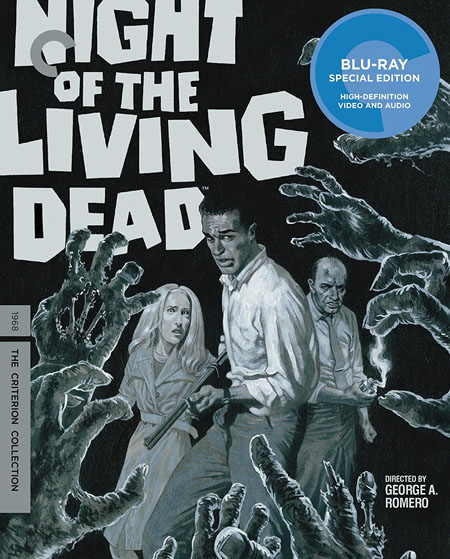
“UPGRADED GHOULSâ€
By
Raymond Benson
For
a film that’s been in public domain for decades and is available on dozens of
different poor-quality DVD labels and free to download from Internet, it’s
somewhat surprising that The Criterion Collection would pull out the stops to
offer an undoubtedly pricier option to own the movie with this lavish 2-disk
extravaganza of gore. (There is a precedent, however—Criterion did the same
thing with the out-of-copyright Carnival
of Souls.)
Don’t
get me wrong… this is a very welcome roll-out. What’s unique about Criterion’s
excellent package is that it features a new 4K digital restoration of the
original theatrical release (not the previously go-to “30th
Anniversary Edition†released years ago and that had been recut a little), and
it’s supervised by co-screenwriter John A. Russo, sound engineer Gary R.
Streiner, and producer Russell W. Streiner (sadly, director George Romero is no
longer with us, or there’s no doubt he would have been involved). There’s also
a new restoration of the monaural soundtrack, that was supervised by Romero, and Gary Streiner, and presented
uncompressed. There are also two separate audio commentaries from 1994
featuring Romero, Russo, actor Judith O’Dea, and others.
What
this means is that you’ll be viewing the most pristine, best-sounding,
razor-sharp edition of Night of the
Living Dead that you’ve ever seen.
If
you don’t know the film, where have you been? It’s one of the most iconic
low-budget, independently-produced horror films ever made. The shoestring
budget was $114,000, and Romero utilized unknown stage actors, as well as
extras from nearby Evans City, Pennsylvania, where the exteriors were shot. It
basically kick-started the “walking dead†genre, although that term and the
word “zombie†is never used in the movie. They’re referred to as “ghouls.â€

For
1968, the picture was ground-breaking, daring, and controversial. Many critics
trashed it for being too gory, even though it’s in black-and-white. Some
countries banned it. Released just prior to when the MPAA ratings were unveiled
in the USA, it was exhibited unadulterated to kids at a Saturday matinee—which
most likely provided a lifelong set of nightmares for these poor individuals.
After the ratings were instituted, the film was rated “X†for some time, until
eventually this was downgraded to “R.â€
Another
envelope-pushing aspect was the casting of African-American Duane Jones as the lead. This was unheard-of in those days
unless it was a Sidney Poitier Hollywood movie. This gave the film a
not-so-subtle subtext about racism, since Jones is battling all-white ghouls as
well as his all-white fellow survivors trapped in an abandoned house. Romero
always said he didn’t intend it that way—he cast Jones simply because he “gave
the best audition.â€
The
story is simple—due to radioactive fallout from a satellite that exploded in
space, the dead are rising and feasting on the living. It’s a national
emergency. A small group of very frightened and often irrational men and women,
and one young teenaged girl, are holed-up in a farmhouse while the ghouls spend
the run-time of the movie trying to get at them.
And,
yes, it’s scary, suspenseful, and contains many scenes daring you not to turn
your head away.
Criterion’s
release contains a treasure trove of supplements. The crown jewel of these is
the early 16mm work print edit of the film, originally titled Night of Anubis. There are several new
features, including interviews with directors Guillermo Del Toro, Robert
Rodriguez, and Frank Darabont about the movie, of John Russo discussing the
genesis of the picture at the industrial film company where the filmmakers were
working, and pieces with Gary Streiner and Russell Streiner. Particularly
interesting are the new interviews with some the ghoul-extras as they are
today, a piece on the film’s style, and—particularly instructional for film
students—a documentary on how Romero and team turned low-budget inadequacies
into assets. There are archival interviews with Romero and actor Judith O’Dea,
and others. An audio interview with the late Duane Jones is exceptionally
poignant and enlightening. Then there are the trailers, the radio spots, the TV
spots, and an essay in the booklet by critic Stuart Klawans.
Once
again, The Criterion Collection has rolled out a red carpet, this time for
living dead people, and the results are outstanding. Highly recommended.
CLICK HERE TO ORDER FROM AMAZON